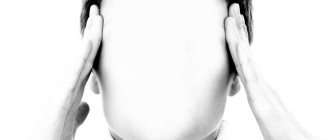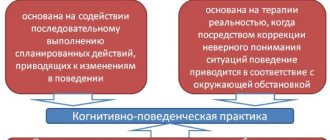Cognitive behavioral therapy: what is it?
Cognitive behavioral therapy is a type of complex therapy that focuses on a specific problem and aims at a specific result. Thanks to cognitive behavioral therapy, you can change the irrational and unconstructive attitude towards the events happening around you, which was formed as a result of incorrect and incorrect development, learning and self-knowledge as a full-fledged and self-sufficient person. This form of therapy combines the best techniques of both cognitive and behavioral therapy.
Cognitive behavioral therapy arose in the 60s of the twentieth century. The fundamental basis of this type of therapy was created by the outstanding psychologist and founder of rational-emotive psychotherapy Albert Ellis and psychotherapist Aaron Beck, who came to the conclusion that the emotions and behavior of any individual depend on the style of his thinking, and the source of any problem that arises in an individual lies within himself, and not in the outside world.
Aaron Beck (left) and Albert Ellis
This universal method of helping people suffering from various mental and neurotic disorders has shown such good results that academic communities have recognized it as one of the most effective and efficient therapeutic treatment methods.
Many people very often perceive negative life attitudes as the ultimate truth and do not realize that patterns, stereotypes and automatic thoughts negatively affect an adequate perception of the surrounding reality. The essence of cognitive behavioral therapy is to help a person who wants to get rid of unconscious destructive conclusions that worsen the quality of his life and cause serious trauma to his psyche, “find” these cognitions and replace them with more constructive, positive and life-affirming attitudes.
Exercises for children
Such exercises are used by doctors and psychologists, exercise therapy instructors, educators, and teachers. They are recommended for children who are often in a bad mood for a long time and who are characterized by stereotypical movements of any nature. Stuttering, enuresis, tics, and twitching may also be indications for body-oriented therapy for children.
Examples of children's exercises:
- Embrace. This is the simplest but most effective exercise. Children stand in a circle and begin to hug the neighbor on the left, the right, the adult leader. Very often the first “hugs” are restrained and tight. But subsequently the child relaxes, and this is the main goal of the exercise.
- Penguins. To keep warm, these birds huddle together, and those on the edge must get into the center. In this case, the teacher or doctor calls the name of the child who is on the edge, and his task is to get to the center of the warm pile.
- Ball. The child is asked to lie on his back and roll the ball over his tummy. He can imagine that the ball is a little sun that warms him with its warmth.
All exercises are carried out in a playful way. The word “treatment” should not appear from the lips of an adult. Parents can also learn some techniques and exercises and do them with their baby at home, in the family circle.
Who is CBT suitable for?
Cognitive behavioral therapy is indicated for those people who want to get rid of:
- social anxiety,
- depression,
- panic attacks,
- obsessive-compulsive disorder,
- certain eating disorders.
With this type of therapy you can:
- increase self-esteem,
- deal with difficulties and problems in relationships,
- procrastination
- perfectionism.
Performing cognitive behavioral therapy exercises helps treat:
- alcoholism
- drug addiction,
- in schizophrenia it is used as a supportive method.
Thanks to cognitive behavioral therapy, a person will be able to change his attitude towards himself as an individual, stop thinking that he is worthless, incapable of anything and a helpless second-class creature. Exercises will help the individual understand and accept the fact that he, like any other person, can make mistakes from time to time. A person will begin to realize that mistakes are a reason to draw the necessary conclusions, correct the situation and move on, and not get hung up on self-flagellation and self-criticism.
A person performing cognitive behavioral therapy exercises will learn to take control of destructive automatic thoughts, life attitudes and other negative cognitions, find a connection between them and their future behavior, independently analyze and correctly perceive any information received from outside.
Cognitive-behavioral therapy is needed for people who want to learn to make decisions on their own that will replace destructive stereotypes, patterns and attitudes that negatively affect the quality of life with more realistic, life-affirming and constructive cognitions.
Benefits and harms
First and foremost, a person who agrees to such therapy must initially accept its conditions and trust the specialist. If you are skeptical about the method, it is unlikely that you will be able to perform the exercises correctly, and in this case, you cannot expect the desired relaxation to occur.
Body-focused therapy helps:
- rid a person of phobias (for example, fear of heights or confined spaces);
- get rid of feelings of guilt and the “eternal debtor” syndrome;
- cope with aggression;
- learn to “breathe” through stress correctly;
- control your emotions.
Therapy classes are attended by people who suffer from such serious illnesses as bronchial asthma, arterial hypertension, coronary heart disease, stomach ulcers, diabetes mellitus, etc. They know that deterioration and exacerbation of disease symptoms are often associated with an inability to respond correctly to stress. Therefore, with the help of body-oriented therapy techniques, they try to gain control over their body, the ability to calm down in a difficult situation, control their emotions and respond correctly.
Body-oriented therapy session
The main possible harm of bodily therapy is the refusal of any other treatment. If a patient has a serious somatic diagnosis, and he only works with a psychotherapist, goes to body practices, he misses the time for treatment - traditional, classical.
There are also very specific risks, such as incorrect treatment. For some time there was a fashion for holotropic breathwork. This is the name for the method of changing consciousness by changing the amount of carbon dioxide and oxygen in the body. The method may be effective, but it is also potentially dangerous.
Therefore, body-oriented therapy is suitable for people who do not refuse basic treatment (if necessary). It is also suitable for children if a qualified specialist works with the child.
Top 6 effective cognitive behavioral therapy exercises
Cognitive-behavioral therapy exercises are preventive therapeutic tools that can reduce or completely eliminate inadequate or destructive perceptions of the surrounding reality, get rid of destructive cognitions that cause negative feelings and emotions and replace them with positive and constructive life attitudes.
There are many different cognitive behavioral exercises. We bring to your attention the most effective and popular of them!
Exercise No. 1. Getting rid of anxiety
Anxiety negatively affects the quality of everyday life, so you should get rid of it as quickly as possible. To do this, you need to find a secluded place where no one will disturb you, put your thoughts in order and ask yourself the following questions:
✔ “Am I destroying my present when I worry and worry about the future?”
✔ “Am I worried because my problem is huge and cannot be solved in any way, or does my anxiety arise because I don’t want to take on the solution to the problem that has arisen, so I’m constantly putting off time?”
✔ “Do I now have the opportunity to take that action (call my boss, make a list, make an appointment with a person I like, etc.) that makes me feel anxious?”
Answer these questions not only honestly, but also as quickly as possible. If you start thinking about each answer for 20 minutes, then you will not be able to answer as truthfully as possible.
As soon as you answer the questions, try to transfer all your worries and worries to the present moment. Do your best to work through the unpleasant feelings and emotions right now. As soon as you do this, you will immediately realize that it is almost impossible to worry and worry about what is happening “here and now”.
Concentrate your attention on your surroundings. Use all your senses to the maximum: look closely at objects and their shades, listen to smells and sounds, pick up an object to feel its texture, etc. Then take a piece of paper and write down all the sensations that you managed to feel and realize.
Now concentrate all your attention on your inner world. Listen to how your heart beats. Observe your hands and feet. Listen to your breathing. Spend time on every part of your body.
A little lower on the same piece of paper, write down the sensations that you were able to feel and realize in the process of studying the inner world and your own physical body.
Think carefully about whether you managed to feel all parts of your own body. If you fail, continue to study your inner world and your physical body until not a single part of your body is left without proper attention.
As soon as you start doing this exercise, anxiety will begin to leave you, and you will be able to calm down, as you concentrate all your attention on an activity of a completely different kind.
Exercise No. 2. We have a dialogue with ourselves
Dialogue with yourself will help you quickly and efficiently get rid of suddenly arising uncomfortable feelings of an emotional or physical nature. To perform this exercise, you should find a secluded and quiet place where you will not be distracted or disturbed.
Take a comfortable position, close your eyes and try to imagine a mirror showing your image. Take a good look at yourself.
✔ What kind of look do you have when you experience discomfort?
✔ Do these uncomfortable sensations show on your face?
✔ Do they affect posture?
Concentrate all your attention on physical sensations. Try to find those places on your body that are the source of unpleasant and uncomfortable sensations.
Then mentally refer to your image, which is reflected in the mirror presented to you. Tell him those words that will help him calm down, find inner harmony, cheer up, get rid of obsessive anxiety, self-flagellation and self-criticism, restore dignity and self-respect.
Don't be afraid to be overly emotional. The more feelings and emotions you put into your words, the easier it will be for your imaginary interlocutor not only to understand, but also to realize them. If your imaginary interlocutor reacts to your words, then this indicates that you are moving in the right direction.
Now concentrate on your physical sensations. If you did everything correctly, then both physical and emotional discomfort will first gradually subside and then disappear without a trace. If you do not observe any changes, then this indicates that your imaginary interlocutor did not hear you, and all your speeches were made in vain. Repeat this exercise until your words hit the target.
Exercise No. 3. Getting rid of false fears
You should get rid of irrational fears that have no real basis, otherwise your daily life will turn into a boring, dull and joyless existence.
The simplest and most effective way to get rid of false fear is to sincerely laugh not only at your own fictitious fear, but also at the fear of this or that fear.
» Example. If you're worried that your guests won't like the new dish you've decided to prepare for dinner, then think about how your guests' approval or disapproval of you has anything to do with you. If they didn't like something, they would definitely tell you about it. If none of the guests said that the dish was too fatty, too sweet or salty, undercooked or overcooked, then this indicates that the dish was tasty and the guests were satisfied with the dinner you offered. Laugh at the fact that you are afraid of what guests will say and wait for approval where it is absolutely not necessary!
If you have a person you trust, then tell him about your groundless fears. Try to show this person all the emotions that you experience when you are afraid of something. If there is no such person in your environment, then stand in front of the mirror and tell all this to your image.
Find the source of your irrational fear and then try to get rid of this incorrect and false idea by replacing it with a more rational and correct idea.
Observe your fears from the outside. Turn off all emotions and imagine that you are an outside and objective observer who makes only adequate and reasonable conclusions. If you do everything correctly, you will be able to understand and realize that all your false fears are petty and insignificant thoughts-leeches that suck all the energy, joy and happiness out of you. To get rid of these little bloodsuckers, you must first find correct and rational attitudes in life, and then replace them with false and destructive cognitions.
» Example. If you feel afraid that other people will see how much you worry about one thing or another, then you should realize that experiencing emotions is a completely natural process in which there is nothing scary or shameful. Only those people who have certain mental disorders and diseases do not feel anything. Normal people constantly experience some kind of emotion!
Exercise No. 4. Defining our own essence
This exercise, which involves observing yourself objectively and dispassionately, will help you identify your own essence and develop self-awareness.
Each of us can be compared to a multi-layered onion. Our true essence is hidden behind social masks that we are forced to constantly wear so as not to show others our real thoughts and feelings, both negative and positive.
Positive feelings and thoughts that we often ignore and suppress will help us identify our true self. To perform this exercise, you need to find a quiet and secluded place where you are sure no one will disturb you.
Take a blank notebook and on the first page write a title in the form of a question:
✔ “What is my true essence?” or “Who am I really?”
Give yourself an honest answer to this question as quickly as possible and write it down in your notebook. Don't think too much about the question or you won't be able to give a really honest answer to it.
In order to answer this important question correctly and completely honestly, you need to discard the opinions of your family, friends, colleagues, and people around you. The only thing that matters is what you think about yourself. You can ask yourself this question several times a day. Remember to put the date before writing down your answer each time.
After answering the question, take a comfortable position and close your eyes. Once again ask yourself the question of who you really are, and then give an answer, but not in writing, but in the form of a visual image that has arisen in your thoughts. This image should not be thought through or adjusted. What is important is the image that immediately arose after your question.
Open your eyes and immediately write down a description of the image in your notebook. What kind of image did you see? Did he have any special features? What about the image that emerged immediately attracted your attention? What meaning does this image have for you? How does this image influence your daily life? Don't forget to describe the feelings that arose when you saw the image.
Get up, go to the middle of the room, freeze in a standing position. Close your eyes, ask yourself the same question, and then carefully watch the movements that your body begins to make. You must not only watch the movements, but also fully feel them. Under no circumstances should you take control of these movements or allow them to be corrected. You must completely trust your body.
Write down or remember all the movements your body made. This is very important, because through movement, your physical body gives you the opportunity to determine your true essence.
Exercise No. 5. Using self-analysis to correct negative behavior
To perform this exercise correctly and achieve maximum results, you need to become a detached, dispassionate and objective bystander. Concentrate your attention on your own feelings, listen to them, be aware of them and remember them, but do not try to change them and do not subject your feelings to any adjustments.
Find a secluded and quiet place where you are sure no one can disturb you. Concentrate all your attention on your physical body. It doesn't matter what pose you take. You can stand, sit or lie down. First, look at how your limbs are positioned, what position your head is in (up or down), whether your back is hunched, etc.
Focus your attention on the areas of your body that are causing pain or discomfort, and then listen to your heartbeat and breathing.
Mentally or out loud say the following phrase: “This is my physical body, but I am not a physical body.” Try to instill this thought in yourself.
Now concentrate all your attention on your feelings. Listen to the feelings you are experiencing at the moment, and then try to find the constructive side of each of the feelings you experience and separate it from the destructive side.
Say the following phrase out loud or mentally: “These are the feelings I experience, but I am not these feelings.” Do your best to instill this thought in yourself.
Now focus all your attention on your desires. List all the desires and aspirations that you currently have. When listing desires and aspirations, do not think about their priority and importance, but simply remember and name them in the order in which they come to your mind.
Mentally or out loud say the following phrase: “These are my aspirations and desires, but I am not these aspirations and desires.” Try to instill this thought in yourself.
Now focus all your attention on your thoughts. Try to catch the thought that is now in your head. If you think that there are no thoughts in your head right now, then this is the thought on which you need to concentrate your attention.
If there are a lot of thoughts in your head, then watch how they replace each other. Don't think about whether these thoughts are right. It doesn't matter whether these thoughts have a rational basis. You just have to focus your attention on them.
Say the following phrase out loud or mentally: “These are my current thoughts, but I am not these current thoughts.” Do your best to instill this thought in yourself.
Requirements for group members
- desire and willingness to communicate with other people and receive group psychotherapeutic help;
- willingness to abide by group rules;
- the ability to withstand emotional stress in a group - it is necessary to understand in advance that the intensity of group work and the high emotional intensity of the process create a certain level of emotional stress - this is partially compensated by the presence of emotional support from psychotherapists;
- a certain responsibility is required from the participant - it is important to understand that what kind of relationships will arise in the group depends on everyone, to be ready to accept honest feedback from other participants - psychotherapists in the group partially ensure the safety of these relationships;
- optimal (but not mandatory) for participation in group psychotherapy is preliminary individual psychotherapy - in this case, the participant will be able to get the maximum result from the course of group psychotherapy; parallel course of drug treatment with another doctor (who is not also a group psychotherapist) is an acceptable condition for participation in the group;
- you need to be internally prepared that improvement and relief will not happen immediately - it will take some time.
Basics of group psychotherapy
I. D. Yalom, an American existential psychiatrist, in his work “The Theory and Practice of Group Psychotherapy” indicated a number of important therapeutic factors for this type of therapy.
They are characteristic of the vast majority of groups:
- Instilling hope. Group members who are at a higher level of recovery and actually demonstrate the effectiveness of the methods used serve as an example for others.
- Altruism. Everyone actively helps each other, thereby increasing their own self-esteem.
- Universality. The experience of overcoming problems, sharing feelings and sensations eliminates isolation between group members.
- Corrective recapitulation of primary family experience. Participants often unconsciously identify the therapist and the entire group with their family. The help of a specialist in this case is aimed at eliminating the unconscious repetition of past useless patterns in the present time.
- Development of ways and methods of communication. Group interaction improves participants' social skills and interpersonal interactions.
- Existential data. Awareness of responsibility for all decisions made earlier, acceptance of their consequences.
- Imitating others. The example usually chosen is a therapist or a more successful group member. The way to really accelerate the development of social skills involves the processes of modeling, observation and imitation.
- Interpersonal learning. The ability to achieve a higher level of self-awareness in a group is associated with the processes of interaction between participants and the receipt of feedback that characterizes their behavior.
- Self-awareness. Through successful interpersonal learning, group members come to a deeper understanding of the unconscious motives and many of the issues that influence their behavior.
- Catharsis. Liberation from negative experiences. Achieved through the free expression of accompanying emotions.
This form of psychotherapy is especially relevant for psychotic adolescents. Systematic work with recovering drug addicts also has a good effect.










